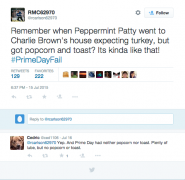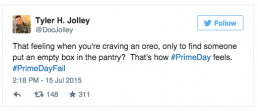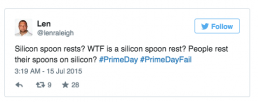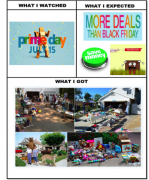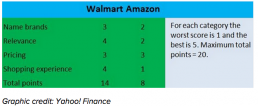PYMNTS’ #PrimeDay Report Card
Amazon asked the American people a question this week.
“Do we as a people need another Black Friday smack dab in the middle of July?”
And the nation – divided as we are on any number of issues – answered back in one voice.
“Yes, yes we do. Bring on the deals!”
And so the nation waited, Prime memberships perked up, news reports abounded of enraptured eCommerce enthusiasts waiting for hands on their digital clocks to strike 12 AM PST so that they could snap up the miraculous doorbusters they were sure were coming. Even the less than entirely enthused spent the days ahead of Prime Day quietly stuffing their carts, building their digital Christmas in July list for Santa in the hopes that Santa Amazon would allow them to snag some spectacular savings on at least some of the items.
Amazon’s announcement also got the attention of lots of other retailers, even those who never really declared themselves fans of discounts. Walmart, known for its everyday low prices, jumped into the action and announced their own 24-hour online deals. And by the time the “actual Prime Day” rolled around, Macy’s, Bloomingdale’s, Toys “R” Us and a slew of other retailers had primed their sales engine pump (yup, pun totally intended) to offers their own variations on the theme.
And then the day happened, and the American people looked upon the deals, looked back at Amazon and asked their own question.
“Is that all there is?”
That question was parsed in many ways throughout the day — as the Twitterverse lit up with consumers who came to Amazon’s birthday party, and found the party favors not to their liking.
“So what I’m getting out of this is that #PrimeDay is some sort of postmodern experiment to see if disappointment can be quantified,” one disappointed tweeter noted.
But before you stick a fork in Amazon’s Prime Day and proclaim it a “disappointment” it’s helpful to remember that there’s a sizable portion of regular social media users who have that reaction to almost everything.
So, in the spirit of bringing you a balanced view of just what happened, here’s the PYMNTS Prime Day Report Card.
Amazon: A-
Comments: Strong premise, smart introduction, respectable results. Some weird product selection to be sure, but Amazon managed to get everyone in the retail world focused on their own “Prime” Day – making their sales all about celebrating Amazon’s birthday.
While Amazon took lots of abuse throughout Prime Day – there is an undeniable element of “laughing all the way to the bank” in its Prime Day outcome.
“Prime Day peak order rates have already surpassed 2014 Black Friday,” said Greg Greeley, vice president of Amazon Prime, in a statement. ”Prime members have already bought tens of thousands of Fire TV Sticks, 35,000 Lord of the Rings Blu-Ray sets, 28,000 Rubbermaid sets, and 4,000 Echo devices in 15 minutes. The Kate Spade purse was gone in less than a minute. We also sold 1,200 of the $999 TVs in less than 10 minutes. And there are thousands more deals coming.”
And while Amazon can be expected to toot its own horn, third-party data seems to back up the claims. ChannelAdvisor reports that Amazon’s daily sales in the U.S. were up around 80 percent as of 12PM EST over last year’s figures, and sales were up 40 percent in Europe.
And perhaps more important that the one-day sales figure, which some analysts suspect Amazon may have lost money on, Prime Day did what it was supposed to do: encouraged more people to sign up for Amazon Prime. Amazon reports that it had more new members sign up for its Prime membership service than any single day in Amazon history, with hundreds of thousands of new people joining. Many of those new members are in a free trial at present, meaning some may fail to convert when it comes time to pay the ~$100 year fee, but a large chunk of those reported hundreds of thousands will either choose to stay on, or merely forget to sign off.
Given that Prime Members convert when they visit Amazon at a 74 percent rate, according to recent research — as opposed to non-Prime members at a 14 percent conversion rate — those hundreds of thousands of new Prime Members are a big pick-up for Amazon.
Amazon, it seems, is aware of this and happy with their results since they plan to do it again next year — and will likely turn Prime Day into an annual event.
“Going into this, we weren’t sure whether Prime Day would be a one-time thing or if it would become an annual event,” Greeley said. “After yesterday’s results, we’ll definitely be doing this again.”
So while the Interweb-wide flip out makes for good headlines about Prime Day being a bust, it seems a bit disconnected from reality even though advertising a deal on a 64-gallon drum of lube is a bit on the weird side. Amazon’s Prime Day was less about the sales and more about acting as a multiplier of Prime customers. Even if a fraction of the “hundreds of thousands” of customers convert to Prime membership, they spend 2-3x more than a non-Prime consumer – exactly the kind of multiplier that retailers would love to sink their teeth into.
Twitter: A (For Amusement)
Comments: Made Amazon’s 20th birthday a lot about them – giving lots of Twitter followers something fun to follow. But how much money again did they make from it? That would be zero.
Fun Saturday morning activity: Google “Prime Day.” Count how many article headlines reference Twitter, #PrimeDayFail, or the great social media revolt against Prime Day. Notice anything odd – like how those articles vastly outnumber articles that do not reference the Twitter freakout in the headline?
At some point in the day, Prime Day stopped being only about shopping, and became about tweeting about shopping.
And not just tweeting — no, Prime Day became a diamond-cuts-diamond competition to express most fully and completely their feelings of disappointment .
From the existential:
To the weirdly fatalistic:
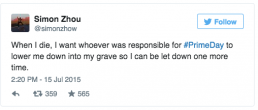
And then there was the avalanche of memes:
And while it would be tempting to declare Twitter the uncontested winner of Prime Day, it is worth mentioning that Amazon made money on Prime Day, and so did Walmart. Twitter made us laugh, but that’s about it. No matter how many #PrimeDay posts they racked up, Amazon is still laughing all the way to the bank.
Walmart B+
Comments: Grabbed up lots of sales, and garnered some good headlines about the product selection after a bit of a rocky start when Walmart’s criticism of Amazon’s “you gotta pay to get the deals” comment landed them a counterpunch to the lack of distinction Amazon makes between its customers.
While we at PYMNTS bet there are a lot of recent headlines that Amazon is feeling cranky about, if we had to pick the one that most is most irritating to them, we are going to guess it is this one from Time magazine.
How Walmart Beat Amazon On Prime Day
It’s certainly click-baity if nothing else, especially since it goes on to note that Walmart wouldn’t likely go down in history for the amazing deals they were peddling on July 15th either – and like those who shopped Amazon, Walmart’s customers also said a lot of the deals were not all that spectacular.
Then there was something published by Yahoo! Finance which compares the product selection made available by both – showing a slight nod to Walmart.
What isn’t obvious from this chart is the fact that both Amazon and Walmart came out equal on pricing, but Walmart seemed to offer a better shopping experience. Walmart didn’t have waiting lists, reportedly staggered its deals throughout the day, pegged to categories that were particularly attractive to parents (particularly in toys and back to school) and avoided angering a massive and vocal swath of the consumer base.
One consumer, writing for USAToday, told the sad tale of getting pumped for PrimeDay only to spend her first hour or two searching for something (literally anything) that she was interested in buying.
The title of that story?
“How I Spent Amazon Prime Day at Walmart”
“Let’s see what Walmart’s doing,” the writer noted after tooling around the Amazon site. Here’s what she wrote when she logged in.
“Thousands of new rollbacks! No upfront fees! Pick up as soon as today! Plus free shipping on orders of just $35!”
“I search ‘free store pickup’ and ‘rollback’: 3,597 results.”
At the end of the story, this consumer buys a $400 TV from Walmart — one that wasn’t even a rollback — because Walmart offered her an on to offline experience. Omnichannel at its finest!
“If I want, I can purchase a brand-new Samsung 40-inch LED Smart HDTV for $397 on the way home. It’s not discounted, but it’s exactly what I want, and I don’t have to buy it today. I like that freedom of choice when it comes to shopping.”
She bought the $400 TV from Walmart. She bought a $15 GoPro accessory (at less than half of its price) from Amazon.
So if Walmart had better products, similar deals, a better shopping experience and no Twitter backlash, how did it score lower than Amazon?
Amazon was hooking Prime fish, and they seemed to get barrels of them. How many of them convert remains to be seen, but Prime Day was less about scoring a sale and more about scoring a relationship with a valuable customer.
Speaking of the customer, they get the best grade of all: A+++.
They literally did have Christmas in July with a raft of sales from every merchant under the sun who paid their ode to Amazon by having their own “Prime Day” sale. Heck, even we at PYMNTS.com got into the act, by offering a Prime Day sale on our Retail Reinvention Summit (August 4/5)!
And, that, at the end of the day, is what shopping is all about – creating a great experience for the customer.
